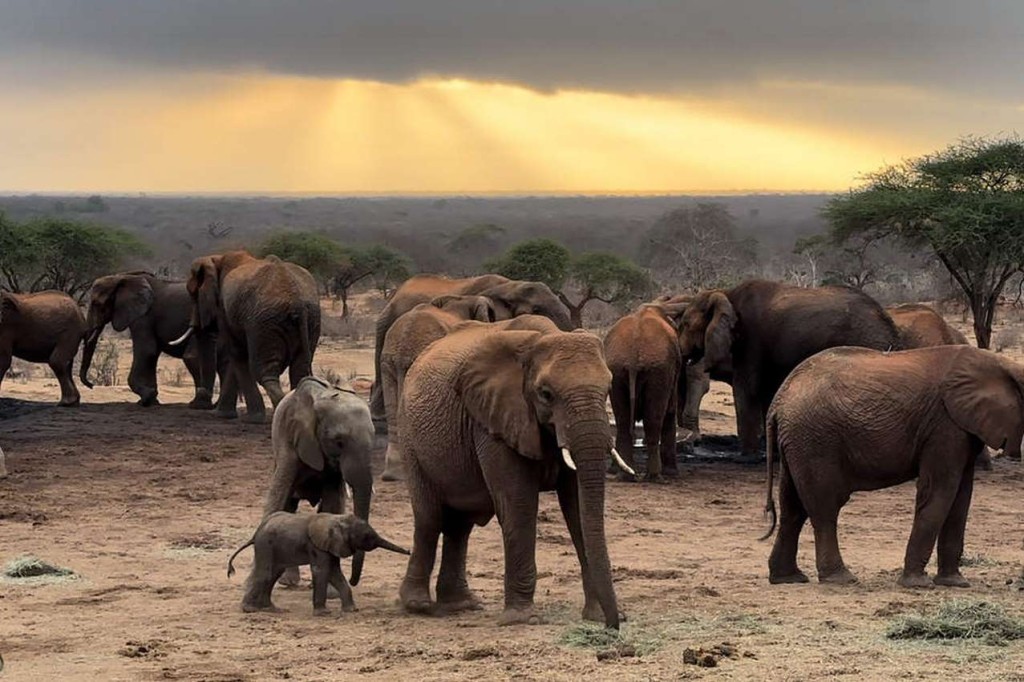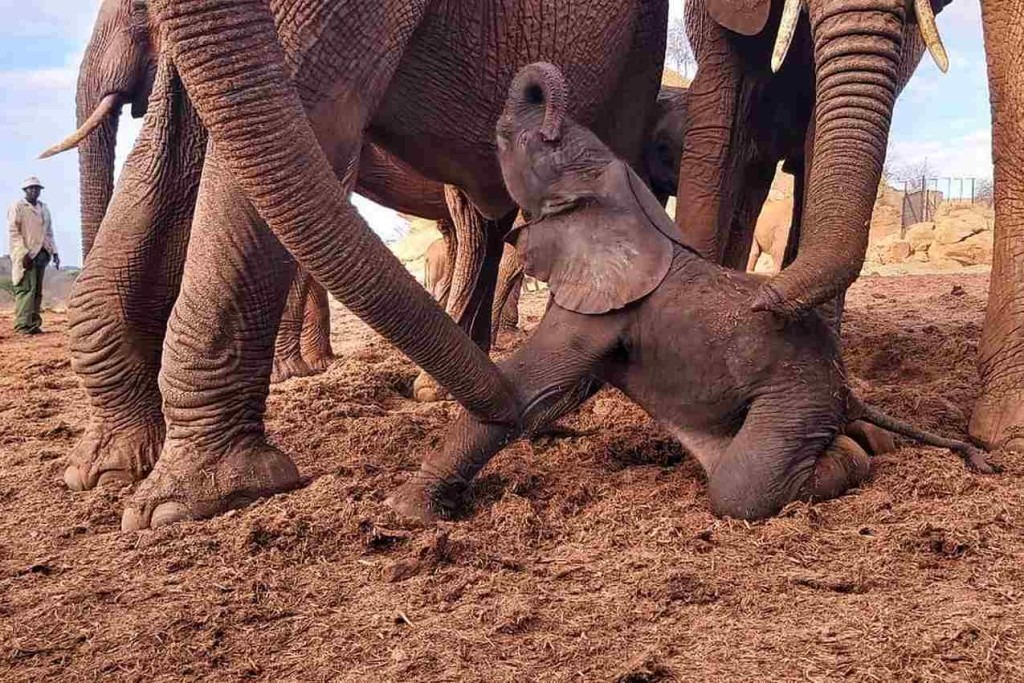A Story of Dawn, Dust, and an Unexpected Miracle
The rising sun had only begun to warm the dry Kenyan plains when an unforgettable moment unfolded at the Sheldrick Wildlife Trust’s Ithumba stockades. What began as a quiet, predictable morning during the dry season soon transformed into a scene of excitement, awe, and heartfelt celebration as a newborn elephant entered the world. For the first time in eight years, a new calf had been born into the orphan herd — a moment so rare and meaningful that even the elephants themselves seemed stunned.
Although elephants are known for their joyful interactions with newborns, the extraordinary reaction of this particular herd revealed something deeper. These were elephants who had once been orphans themselves, raised by humans, rehabilitated, and eventually returned to the wild. Their shared histories created a bond that went far beyond instinct — one shaped by memory, resilience, and years of gentle care. When the new baby appeared, that bond was displayed in ways that left keepers speechless and reaffirmed the power of community among these remarkable animals.

A Tradition Rooted in Trust and Reunion
For decades, the Sheldrick Wildlife Trust has been a sanctuary for orphaned elephants across Kenya. The organization rescues calves that have been separated from their herds and raises them through individualized care and gradual reintroduction into protected wilderness. Over time, a touching tradition has emerged: many rehabilitated females return to the Trust after giving birth, inviting their human caregivers to share in the joy of new life.
These visits symbolize a lasting connection between elephants and the people who nurtured them. Staff members often describe these reunions as emotional reminders of what patient care and long-term conservation can accomplish. Yet the morning of October 29 felt different from previous celebrations. This birth took place not on the outskirts of the stockade or during a scheduled visit but right in front of the orphan herd itself, as if the new mother had chosen to bring her baby into a circle of familiarity and support.

The Moment That Captured the Herd’s Attention
Head Keeper Benjamin had just started his daily rounds when he heard what sounded like a burst of energy ripple through the elephants gathered near the stockades. Trumpets echoed across the dry landscape. Ears flapped. Dust rose. Even the calmest elephants appeared uncharacteristically animated.
As Benjamin approached, he saw the source of the excitement: a tiny elephant lying on the ground, still partially covered in a thin white membrane. The wild bulls were startled and moved aside, while the older females stepped forward with urgency and curiosity. In a cluster of quick movements, the herd’s experienced matriarchs surrounded the newborn.
The mother was Melia, a former orphan rescued at only eleven months old. Confident and strong in most aspects of her life, she now stood motionless, almost puzzled, gazing at the infant she had just delivered. Her stillness reflected both wonder and uncertainty — emotions that are not unusual among first-time elephant mothers.
The Wisdom of the Matriarchs
Elephants live in societies guided by matriarchs and elder females who carry generations of knowledge. This wisdom extends into every part of elephant life, including the arrival of newborns. In Melia’s moment of hesitation, experienced females stepped in with instinctive guidance.
Loijuk, one of the herd’s respected older females, took the lead. She gently nudged the newborn with her legs, encouraging him to stand. Other members of the group formed a supportive semi-circle as if creating a safe nursery within the bustling herds. Throughout the process, the bulls watched quietly, seemingly aware that a unique moment was unfolding.
Experts believe that maternal cooperation is a core part of elephant culture. The help of experienced females not only comforts the mother but ensures that the newborn gains the strength and stability needed in its first hours. In many African traditions, elephants are often associated with wisdom, patience, and unity — qualities the herd displayed so clearly that morning. Although cultural interpretations vary, the sight of these elephants working together seemed to echo long-held beliefs about their deep emotional connections.

The Slow Awakening of Maternal Instinct
With Loijuk’s guidance, Melia began to understand the needs of her child. She leaned down carefully, wrapped her trunk around the newborn, and made her first tentative attempt to guide him toward her side. Nursing did not come easily at first; she struggled to position herself and lower her body enough for the calf to feed. But each attempt revealed her growing confidence.
By midday, Melia had embraced her new role. She moved with purpose, shielding her baby, adjusting her stance, and guiding him with the gentlest of touches. Her transformation illustrated the adaptability and emotional depth elephants are known for — qualities that scientists continue to study with fascination. Research suggests that elephants experience learning curves similar to those seen in many species, including humans. New mothers often rely on the example of older females, leading to a communal approach to parenting.
A Baby Named Milo
The newborn calf was later named Milo, meaning “beloved,” a fitting tribute to the affection that surrounded him from his first breath. Milo became the 53rd elephant born to the Sheldrick orphan herd, a milestone symbolizing not only population growth but the success of long-term conservation approaches. For an organization that specializes in healing, rescuing, and rehabilitating, each new calf represents the continuation of a story that began with compassion and collaboration.
Milo’s arrival brought renewed attention to the challenges and successes of conservation in Kenya. Supporters from around the world expressed joy and hope as the news spread, and the Trust later announced that Milo would be available for symbolic adoption — a fundraising effort that helps sustain veterinary care, habitat protection, and keeper programs.

Understanding Elephant Behavior Through Science
While the morning’s events were moving, they also offered valuable insights into the behavior of elephants living in semi-wild, human-supported environments. Scientists who study elephant societies note that their interactions blend instinct with learned experience. For example, elephants raised among humans often develop additional layers of trust, empathy, and social curiosity.
The birth provided an opportunity for researchers and keepers to observe how former orphans respond to major life events. The collective reaction demonstrated the importance of social bonds in elephant herds. Studies show that elephants communicate through vocalizations, gestures, trunk touches, and even low-frequency sounds that travel long distances. Although the exact meaning of each behavior is still being researched, many experts agree that elephants display emotional intelligence comparable to that of highly social mammals.
Cultural Significance and Human Connection
Across many African cultures, elephants symbolize strength, leadership, and memory. Their ability to form lifelong bonds and maintain close-knit family groups reflects values cherished in human communities. The Sheldrick herd’s celebration of Milo’s birth resonated deeply with people around the world, not only because it was rare but because it mirrored human traditions of welcoming new life.
For the keepers, who spend years caring for orphaned elephants, the birth represented a full-circle moment. It reaffirmed that the love, effort, and dedication invested in each orphan can extend far into the future, influencing the next generation of elephants born into freedom.

A Morning That Became a Milestone
As the sun climbed higher that October morning, the herd settled into a peaceful rhythm. Milo stood shakily between the legs of his mother and the protective presence of the matriarchs. Melia, once unsure, now guided him confidently through his first steps. The keepers watched from a respectful distance, aware that they were witnessing a moment of profound significance — one that symbolized resilience, continuity, and the hope embedded within conservation work.
Conclusion: A Reflection on Wonder and Human Curiosity
The birth of Milo was much more than a biological event. It was a story of community, learning, and the powerful connections that form between living beings. It reminded us that nature is full of moments that inspire curiosity, compassion, and reflection. As we continue to learn from elephants — their intelligence, their patience, and their remarkable ability to care for one another — we also deepen our understanding of what it means to coexist with the natural world.
Stories like Milo’s spark questions that fuel our curiosity: How do animals learn from one another? What memories do they carry? How do their bonds shape their future? These questions keep our fascination with wildlife alive and encourage us to protect the environments where such wonders can unfold.
Sources
Sheldrick Wildlife Trust – Official Updates and Conservation Information
International Fund for Animal Welfare – Elephant Behavior and Conservation Studies
National Geographic – Research on Elephant Social Structures and Intelligence
African Wildlife Foundation – Kenya Elephant Conservation Reports
